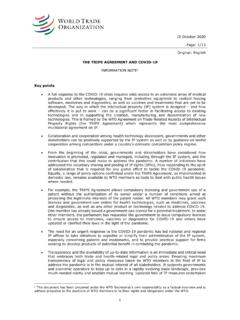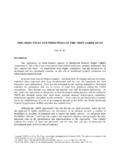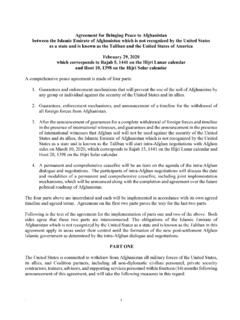Transcription of Introductory Handbook on The Prevention of Recidivism …
1 Introductory Handbook onThe Prevention of Recidivism and the Social Reintegration of OffendersCRIMINAL JUSTICE Handbook SERIESC over photo: Rafael Olivares, Direcci n General de Centros Penales de El NATIONS OFFICE ON DRUGS AND CRIME ViennaIntroductory Handbook on the Prevention of Recidivism and the Social Reintegration of OffendersCRIMINAL JUSTICE Handbook SERIESUNITED NATIONSV ienna, 2018 United Nations, December 2018. All rights designations employed and the presentation of material in this publication do not imply the expression of any opinion whatsoever on the part of the Secretariat of the United Nations concerning the legal status of any country, territory, city or area, or of its authorities, or concerning the delimitation of its frontiers or production.
2 English, Publishing and Library Section, United Nations Office at first version of the Introductory Handbook on the Prevention of Recidivism and the Social Reintegration of Offenders, published in 2012, was prepared for the United Nations Office on Drugs and Crime (UNODC) by Vivienne Chin, Associate of the International Centre for Criminal Law Reform and Criminal Justice Policy, Canada, and Yvon Dandurand, crimi-nologist at the University of the Fraser Valley, Canada. The initial draft of the first version of the Handbook was reviewed and discussed during an expert group meeting held in Vienna on 16 and 17 November suggestions and contributions were made by the following experts at that meeting.
3 Charles Robert Allen, Ibrahim Hasan Almarooqi, Sultan Mohamed Alniyadi, Tomris Atabay, Karin Bruckm ller, Elias Carranza, Elinor Wanyama Chemonges, Kimmett Edgar, Aida Escobar, Angela Evans, Jos Filho, Isabel Hight, Andrea King-Wessels, Rita Susana Maxera, Marina Menezes, Hugo Morales, Omar Nashabe, Michael Platzer, Roberto Santana, Guy Schmit, Victoria Sergeyeva, Zhang Xiaohua and Zhao Linna. The following UNODC staff members also contributed to the development of the first version of the Handbook : Piera Barzan , Estela M ris Deon, Fabienne Hariga, Val rie Lebaux, Alexandra Martins, Philipp Meissner, Anna Giudice and Miri 2017, UNODC initiated a revision of the 2012 version of the Handbook , among other things, to consolidate its content and to fully incorporate the provisions of the United Nations Standard Minimum Rules for the Treatment of Prisoners (the Nelson Mandela Rules), which had been adopted by the General Assembly in its resolution 70/175 of 17 December 2015.
4 Vivienne Chin and Yvon Dandurand, who had prepared the 2012 version of the Handbook , also prepared the revised version. UNODC staff members Philipp Meissner and Muriel Jourdan-Ethvignot undertook the final review of the revised version. The following UNODC staff members also contributed to the development of the revised version: Piera Barzan , Anja Busse, Anna Giudice, Sven Pfeiffer, Dayan Farias Picon and Ehab Salah. UNODC wishes to express its gratitude for the support provided by the Government of Qatar for the development of the revised version of the Handbook , including its translation into Arabic, French, Russian and Spanish, under the Global Programme for the Implementa-tion of the doha declaration .
5 Towards the Promotion of a Culture of revised version of the Handbook is dedicated to prison and probation staff, as well as to service providers and volunteers who work towards fostering the social reintegration of offenders around the 133578111316 invest in the social reintegration of offenders? international standards and are social reintegration programmes? link between social reintegration and public Prevention of Recidivism and related risk to invest in the social reintegration of the legal framework and collecting relevant inter-agency cooperationIV.
6 Prison-based rehabilitation international standards and interventions and services and international standards and and re-entry release supervision and the role of the communityVI. Non-custodial sanctions international standards and policies and social inquiry and community and restorative justice77viVII. Special categories of offenders 81A. Children in conflict with the law 81B. Women offenders 94C. Other offenders with special needs or posing special risks 104 Annex. Other relevant publications of the United Nations Office on Drugs and Crime 123 Glossary 1251I.
7 IntroductionThis Introductory Handbook on the Prevention of Recidivism and the Social Reintegration of Offenders is a revised version of the 2012 publication with the same title. It is part of a series of practical tools developed by the United Nations Office on Drugs and Crime (UNODC) to support countries in preventing crime, implementing criminal justice reforms and strength-ening the rule of law. The tools are meant to assist countries in implementing United Nations standards and norms in crime Prevention and criminal justice. The publication focuses on the Prevention of Recidivism and emphasizes the crucial importance of effective programmes to supervise and assist offenders and support their social reintegration.
8 Incarcerated offenders face very real challenges at the time of their release, and communities become unsafe when offenders are released without adequate preparation, supervision or support. Following the publication of the first version of the Handbook , in 2012, two important events occurred that re-emphasized the importance of the rehabilitation and social reintegration of offenders. The first event was the adoption in 2015 of the United Nations Standard Minimum Rules for the Treatment of Prisoners (the Nelson Mandela Rules) (General Assembly resolu-tion 70/175, annex); relevant provisions of the Nelson Mandela Rules are reflected in the present version of the Handbook .
9 The second event was the development by UNODC of the Global Programme for the Implementation of the doha declaration : Towards the Promotion of a Culture of Lawfulness, which followed the adoption of the doha declaration on Inte-grating Crime Prevention and Criminal Justice into the Wider United Nations Agenda to Address Social and Economic Challenges and to Promote the Rule of Law at the National and International Levels, and Public Participation (Assembly resolution 70/174, annex) at the end of the Thirteenth United Nations Congress on Crime Prevention and Criminal Justice, held in doha in April 2015.
10 This four-year initiative includes a major component on fostering prisoner rehabilitation, reflecting Member States commitment, expressed in the doha declaration (Assembly resolution 70/174, annex, para. 5 (j)), to implement and enhance policies for prison inmates that focus on education, work, medical care, rehabilitation, social reintegration and the Prevention of Recidivism , and to consider the development and strength-ening of policies to support the families of inmates, as well as to promote and encourage the use of alternatives to imprisonment, where appropriate.

















